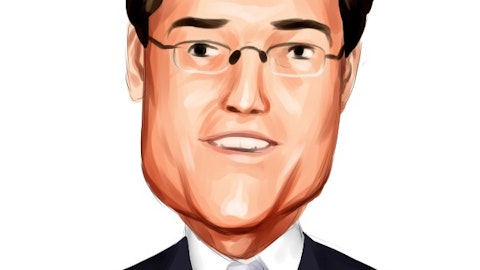Sidney Ho: Great. Thank you. I want to double click on the comments on the DRAM business. If I just look at your Semi systems revenue for DRAM this year, it’s tracking to grow 10% to 20% and even exceed the last peak year in ’21. But the market is still down quite a bit. The question I have is, how much of this outperformance comes from the market being maybe a lot better than we thought, versus maybe share gains that you may have? Are you seeing anything structural that drives the capital intensity of that DRAM business to be higher? And my last part of it is, is just to clarify, you talked about expecting demand for your DRAM products to remain strong, which I assume means roughly flat in ’24. Is that also true for the DRAM market in terms of WFE spend? Thanks.
Brice Hill: Yeah. Thanks for the question, Sidney. So, we do think the DRAM business was strong this year, partially strong because of some of the shipments to China customers, where the process they’re running was recently clarified to be within the rules, within the allowed trade rules. So that’s a partial explanation. But I think we — when we think of that market, we think that it actually looks like a normal year even without those China shipments that the DRAM market was fairly strong from an equipment perspective. And that matches, recent years where a lot of the spending is technology upgrades, not necessarily new capacity. And we expect that to continue over time.
Gary Dickerson: Yeah, Sidney. Just talking with customers, certainly the forecast from them for compute memory is stronger than storage memory. And if you look just at one example on an AI server, the DRAM content there is much higher than an industry standard server. So again, just, I’ve spent a lot of time on the road this last three months, and they — customers are pretty optimistic about DRAM longer term and compute memory demand.
Sidney Ho: Thank you.
Operator: Thank you. One moment for our next question. And our next question comes from the line of Brian Chin from Stifel. Your question please.
Brian Chin: Hi, there. Good afternoon. Thanks for letting us ask a question. One of your peers recently stated that AI could account for 6 billion of WFE next year. I think more than double the contribution of this year. I know it’s difficult to benchmark against these figures, but can you provide a reference point on how you see AI augmenting WFE spending this year, next year, or even beyond, and just kind of maybe a two-parter, but just a clarification, but advanced foundry logic spending, it’s coolly dipped in calendar second half. But tying in your earlier comments, it sounds like you expect foundry logic to improve off these lower levels in calendar first half of next year. Is that correct?
Brice Hill: Okay. Thanks, Brian. On the first part for AI, last cycle, we provided some data points that I think are the relevant data points. We believe about 5% of our WFE is supporting AI workloads. That’s not just Gen AI, but all AI workloads. And we did highlight that we expect that to grow at — probably at 30% or higher CAGR going forward. And I think that’s fair. So, whatever WFE number you’re using, I think if you use 5% and use your 30% growth rate, that’s what we think in our equations. And that would be true for leading logic and that would be true for, HBM on the DRAM side. And then on the second question, it’s really the advanced logic, we’re expecting to accelerate in the second half of ’24. In our first half guidance — sorry, in our first quarter guidance, it’ll really be another quarter of strong ICAPS and strong DRAM.
No — not — it’ll be similar in strength from a leading logic and NAND to prior quarters. So you still have that dynamic in Q1. So it’ll really be second half that we see improving leading logic.
Brian Chin: Thanks. Appreciate it. Thank you.
Brice Hill: Yeah.
Operator: Thank you. One moment for our next question. And our next question comes from the line of Charles Shi from Needham & Company. Your question please.
Charles Shi: Hey, good afternoon. Hi, thanks. I think you mentioned in your prepared remarks you expect the WFE to grow as fast or faster than semiconductors, which kind of implies you are thinking WFE intensity, which probably is already at the roughly 20-year high this year to go — there may be upside to go higher. So really just want to understand your thinking behind, where could the upside be? For example, I think your largest customer in Taiwan is expecting their capital intensity from the current 40% something level to go to what they think is normalized level in the 30s. How do I reconcile your statement versus their statement? Thanks.
Brice Hill: Okay. Thanks, Charles. It’s hard to — we probably won’t compare with anybody else’s comments, but from our perspective, it has been growing. One of the reasons it’s been growing is because ICAPS, that particular business, the mature product technologies, as we’ve described before, there used to be available, used facilities and available used equipment, and it’s really no longer the case. The industry is growing, and without that, just new investments have to be made in wafer starts and capacity, and that’s raised the overall intensity level. When we think to the other types of equipment processes, DRAM, NAND, and leading logic, we expect those to be more intensive with more steps from an equipment perspective, requiring new capabilities and new technologies. And that’s actually what our R&D is engaged in. So it’s, more than intuition that we expect that intensity to go up over time.





